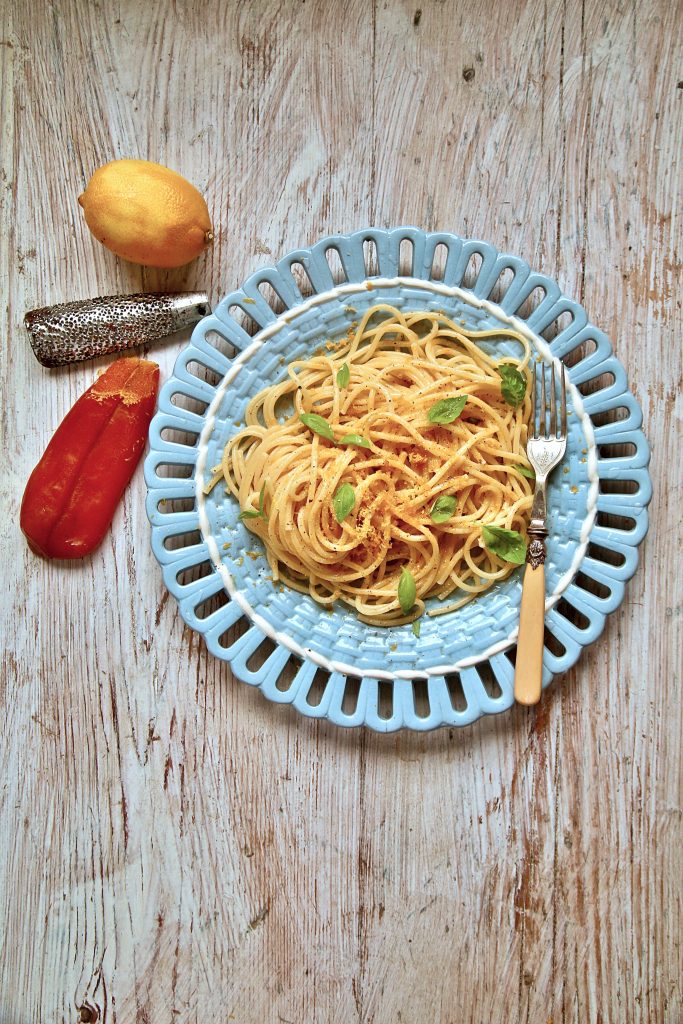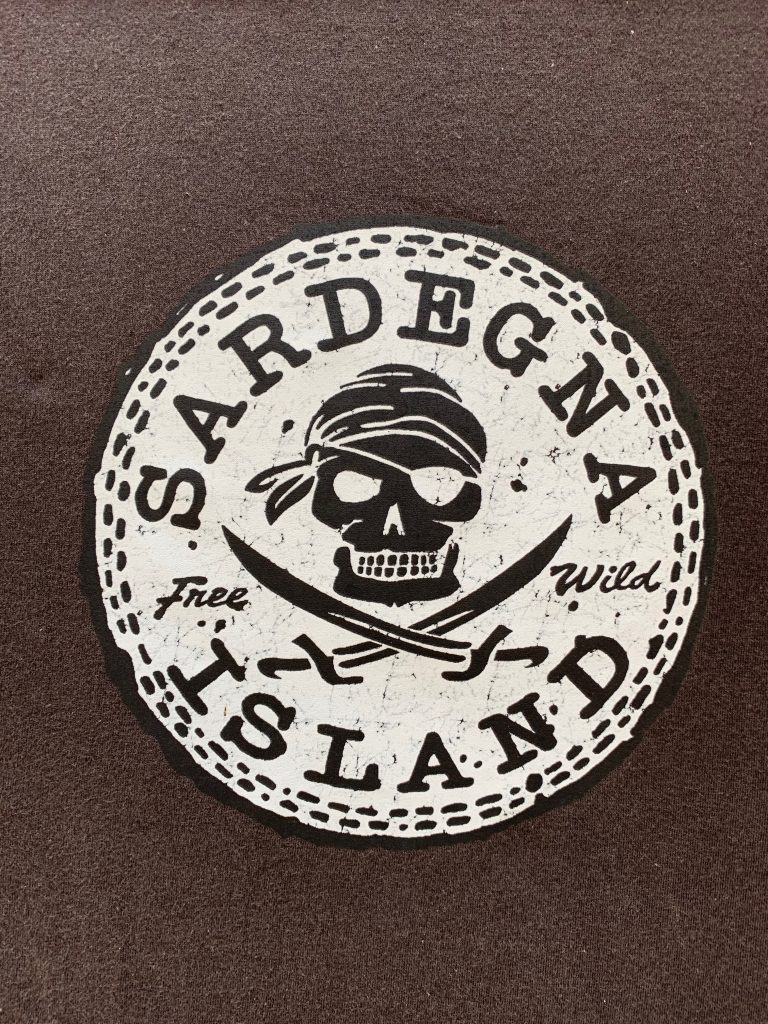This press trip, unusually, was set up by Alghero Airport, (direct flights from Luton, near London) to the North West of Sardinia, to encourage people to fly there. Which is a smart move. Unless people know about your destination, who will fly there?
Catalan Alghero
Alghero (or Alguér, pronounced Algay) is a Catalan city, where a quarter of the population speak an old-fashioned Catalan dialect ‘Algherese’, the street signs are in Italian and Catalan, the independence of Catalunya is recognised with a local consulate, have a Catalan language newspaper, a TV channel, and eat an Algherese version of paella.
Sardinia has the most centenarians in the world (it’s now taken over from Japan) and, atypically, the ratio of men to women is 1:1. In the streets of Alghero is a stunning exhibition of photos of the centenarians, averaging 104 years old.
Food and Wine
Sardinia’s healthy population is thanks in part to the food and wine. I visited Tenute Delogu, a vineyard which produces really good wines from local grapes: Vermintino (originally a Spanish grape) white wines, Cagnulari and Canonau (my new favourite grape) red wines.

The view from Hotel Catalunya 
Alghero
The best Negroni is apparently, according to one of my readers, the 9th floor bar at my hotel: Hotel Catalunya. Spectacular views and worth the wait for the lift up at sunset.
Sardinian cuisine is celebrated for the sheep’s cheese, Pecorino: ivory truckles are enticingly chipped, not cut, even for breakfast, from the ubiquitous sheep. There is also a goat version. A smooth creamy Ricotta is popular in both savoury and sweet, drizzled with intense local honey, forms. Casu Marzu is the famous jumping maggot-filled cheese. I didn’t get to try this or even see it (thank god) but it’s not so unusual when you consider that the original British Stilton had port poured into the middle for exactly the same reason – to kill off the worms.
Pasta dishes include Culurgiones, large soft potato and mint filled pasta shapes with a wheat-sheaf plaited seam; fregula (like giant couscous) and lorighittas, a twisted ring.
Thin crispy Pane de Carasau, similar to Carta di Musica, is the most common local bread, a shepherd food which lasts for days. There are offshoots like the even thinner sourdough Pane Pistoccu (twice cooked), similar to tortilla chips. I saw Pane Frattau made at Tenuta Li Lioni, an Agriturismo restaurant, which is the thin rounds of crisp bread dipped for micro-seconds in stock, spread with a tomato sauce, pecorino and finely a chopped up runny fried egg. Finally it’s baked and cut into triangles like a pizza and the triangles are rolled up. It’s rather like a soft savoury crepe.
Pizza: as well as the usual disks of dough and calzone, can also be served twisted into layers, called sfilatino. Try this at Ristorante Pizzeria La Pergola.
Bottarga, particularly grey mullet, is pressed, smoked, cured fish eggs. In Sardinia, they shave it on to spaghetti vongole, giving it an extra umami fishy oomph. I had this dish at Hotel Punta Negra at the beach. Buy some bottarga to take home. It lasts for a year kept in the fridge and is a great present. Buy grey mullet bottarga in the UK from Delicatezza. Buy whole not grated, it loses flavour otherwise.


Myrtle liqueur and leaf
Myrtle is an important local herb used in cooking (for instance suckling pig at Tenuta Li Lioni) and for a berry dark liqueur, Mirto. This was served after most meals.
Archeology
As well as historical walled cities, great food and wine, Sardinia offers a kind of raw archeology, sites still being uncovered, to which you can get unbelievably close. On one site, the Roman baths in Porte Torre, I picked up a stray piece of Roman white marble mosaic I found on a path.
“You can’t do that!” exclaimed the guide in shock.
“I’ll put it down then” I said.
“Where did you find it?”
“Over there” pointing to a pathway.
Someone in our group explained patiently that where an object is found is important on an archeological dig as it indicates where it might be from.
I put it back in as near to the place I found it as I could remember.
The baths were filled with fresh water from the hillsides, with sophisticated underfloor heating systems, warmed by a wood fired oven. The mosaics were decorative but also were a kind of trompe l’oeil, with waves and fishes giving rise to a sensation of being at sea. Men and women visited at different times and there was a Roman shopping mall adjacent selling soaps, unguents and snacks.
The frustrating issue for Sardinia and the last place I visited, Kassandra, is that there isn’t the money to invest into unearthing all the ancient remains. Both countries aren’t very well off and naturally jobs, medicine, schools all come before expensive excavations.
You can’t take a step without stumbling upon pre-history. And being the second largest island in the Mediterranean, after Sicily, Sardinia, is bulging with archeological remains: Roman, Bronze Age and Stone Age.
The most intriguing archeological remains, bee-hive shaped towers of stone with interior circular stairways, like megalithic castles, are that of the Nuraghe, a mysterious Bronze Age (1600 BC) civilisation. We don’t even know what they called themselves as there is no writing from the period. The building techniques were incredibly advanced for the time and Sardinia was probably one of the richest places on earth with gold, copper and obsidian stone (sharper than steel and the factual basis for the Game of Thrones fictional ‘dragon glass’).
There was some crossover between the Nuraghe and the Romans when the latter invaded 250 years before Christ. The Romans occupied the coast, pushing the Nuraghe into the ‘barbaric’ interior, where they reared animals rather than fished. Roman rule meant that Sardinia, like Sicily, became the bread basket for Roman troops.
Sardinia, since 1861, is part of Italy although proud Sardinians will grump: “We are Sardinian, not Italian”. Unlike Corsica, their independence movement has never been violent. Although being a mediterranean island, they’ve been colonised by Phoenicians, Carthaginians, Romans, Arabs and Spanish.
Sardinia boasts the only ziggurat in Europe, Monte d’Accoddi, similar to Mesopotamian ziggurats, apparently built by the Ozieri culture around two thousand years before the Nuraghe.

Nicola Castangia, archeo photographer 
Anghelu ruju tomb
The Ozieri culture also built the Necropolis of Anghelu Ruju, also known as Domus de Janas, ‘witch or fairy houses’, underground tomb houses with bull’s horns, a symbol of Taurus, carved above doorways. (In astrology and archeoastronomy this correlates with the Age of Taurus, approximately 4000 BC to 2000 BC. Each Great Year lasts around 2,160 years. We are moving into The Age of Aquarius which will last from 2000 to 4000 AD.)
Photographer Nicola Castangia has been photographing this archeological remains for years and has an exhibition at Alghero Airport. Sardinian expert James Martin wrote about him here.
Nature:
The coast is spellbindingly beautiful with a boat trip to Neptune’s Grotto possible if weather allows or a steep staircase (654 steps) if not. You can go on a dolphin boat trip with Naturalghero who took me for a coastal drive to see Griffon vultures and the Little Owl, native to Sardinia. I got chatting on the drive:
Do you have a favourite dolphin?
Yes. I like one in particular and say hello to him by putting my hand in the water near to the bow. The thing about dolphins is they are always having sex, up to 50 times a day.
This led to a conversation about dolphin penises, which are like a hand and can grab things and a documentary of a woman who had a relationship with a dolphin. The guide didn’t know about this.
Jewellery
Sardinia is famous in particular for two types of jewellery: red coral and gold filigree. Alghero is the centre for Red Coral, corollium rubrum, which used to surrounded the north west coast but is now protected. Be careful when you buy it, it could be a Korean tree branch which imitates red coral.
I watch gold filigree expert Pierandrea Carta twist two threads of gold into a strong chain by rubbing them back and forth between two small planks of wood. The third of his generation to work as a jeweller, he uses vintage designs by his grandfather Francesco.
Look out also for the gorgeous monochrome wicker work bread baskets.

Spaghetti with grated bottarga, lemon zest, black pepper and basil
Ingredients
- 500 g good quality spaghetti, 11 mins cooking time
- 1 tbsp Sea salt for water, a decent amount that penetrates the spag
- 4 tbsps olive oil, extra virgin
- 1 lemon, zested
- 25 g bottarga (grey mullet) or more if you wish, finely grated
- A fist of basil leaves, picked from the stems
- A good few turns of fresh black pepper
Instructions
- Cook the pasta in boiling salty water for a minute or two less than packet time.
- Strain and sling it back in the hot pan, toss in the olive oil
- Grate in the lemon zest (taking care not to touch the white bitter part)
- Dish it up and grate on the bottarga, scatter some basil, grind on the pepper.




































Leave a Reply